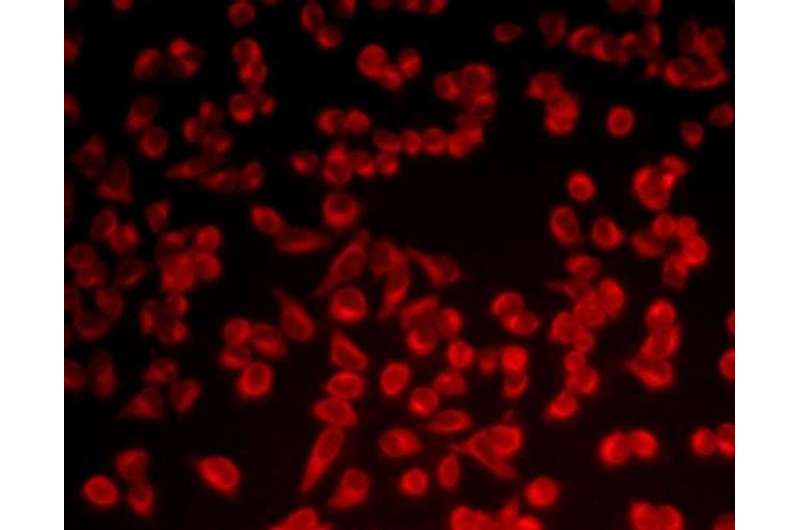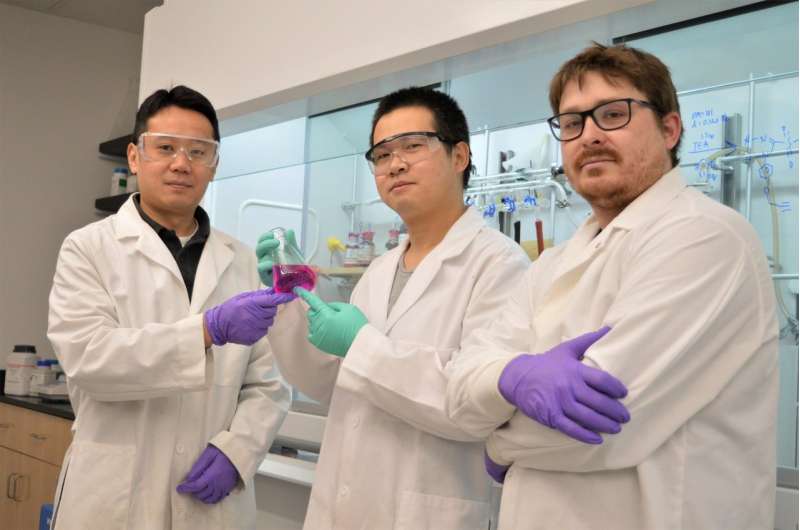Chemists develop novel Washington Red dye for bio-imaging

Washington State University scientists have created an injectable dye that illuminates molecules with near infrared light, making it easier to see what is going on deep inside the body.
The new dye will help medical researchers track the progression of a wide array of diseases, such as cancer.
Ming Xian, the Ralph G. Yount Distinguished Professor of chemistry, calls the new dye Washington Red. He and Wei Chen, an assistant research professor in the WSU Department of Chemistry, published a new study detailing the dye's unique properties and how it is made in Angewandte Chemie, one of the top chemistry journals in the world.
"Near infrared light passes right through the human body, making it almost invisible and making dyes that respond to this color of light perfect for bio-imaging," Xian said. "Washington Red is a unique and inexpensive dye that I see being put into use in many areas."
Fluorescent bio-imaging breakthrough
Fluorescent bio-imaging is the visualization of cells and other biological tissues marked with a dye that glows when activated by light.
It is used to observe disease biomarkers and other biological compounds in real time and helps doctors identify and treat blood clots, heart disease, tumors and other dangerous abnormalities.
Most commercially available dyes for bio-imaging fluoresce in the visible spectrum with wavelengths between 400-600 nanometers. There are several practical issues with these dyes. For one, molecules in amino acids, hemoglobin and other natural tissues and fluids also fluoresce when illuminated with colors of light in this region of the spectrum, such as green and blue.

This natural luminescence makes it hard to tell the difference between what the dye is targeting and surrounding tissues. Shorter wavelength light can even damage cells, making dyes of these colors risky to use in live tissues.
Near infrared light, or light with a wavelength between 650-900 nanometers, is ideal for bio-imaging because it penetrates deep into tissues without damaging natural cells or causing them to fluoresce.
Dyes that show near infrared light have proven extremely hard to make, however, and tend to be limited in application.
Xian's new Washington Red dye differs from these in several ways. The fabrication process is simpler and the dye is easy to quench, meaning that it is not going to shine near infrared until it has located and bonded to its target. Washington Red is also highly tunable. It can be modified to seek out and bond to a wide variety of molecules, gases and other substances in the body.
"Compared to other near infrared dyes, our dye is easy to make and can be modified to target many different biological compounds," Xian said. "It could be used to track the progression of a wide variety of diseases and to study specific biological processes, such as inflammation in the heart or the buildup of tumors cells, which could eventually lead to the design of new drugs and medical therapies."
Xian worked with the WSU Office of Commercialization to file a patent for his Washington Red dye so it can be used by researchers at other institutions across the country and world.
"The ability to light up specific molecules inside living creatures has many potential applications, Xian said. "We look forward to collaborating with other research groups and supplying them with Washington Red so they can pursue their own unique investigations."
Xian's research is in keeping with WSU's Grand Challenges, a suite of research initiatives aimed at large societal issues. It is particularly relevant to the challenge of sustaining health and addressing the onset and progression of disease.
More information: Wei Chen et al, A General Strategy for Development of Near-Infrared Fluorescent Probes for Bioimaging, Angewandte Chemie International Edition (2017). DOI: 10.1002/anie.201710688
Journal information: Angewandte Chemie , Angewandte Chemie International Edition
Provided by Washington State University



















